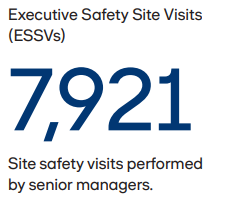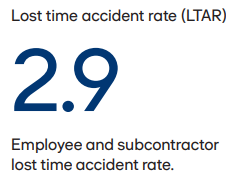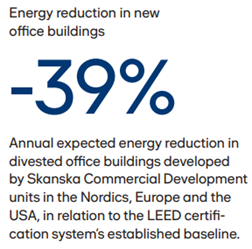We see a world where sustainability is simply built into living. Together with our partners, we are building for a better society, creating innovative and sustainable solutions that support living beyond our lifetime.
Our sustainable impact areas
Our sustainable impact areas
Responsibility
A responsible business for people & planet
Being a responsible business, inside and out, means having a strong and committed health and safety approach that protects lives and well-being. It means acting fairly and ethically, exercising integrity in all decisions, and being a trusted business partner with respect to the supply chain. It means operating with care for local environments and communities. It involves using our full potential by embracing diversity and creating inclusive environments.
Fair and ethical business, inside and out
We act fairly and transparently in our business and decision making, aiming for a culture where everyone working with us understands that they can speak up and also chooses to do so. We strive for environmentally and socially sustainable supply chains that ensure safe and fair conditions for all. We have zero tolerance for corruption, bribery or any other kind of unethical behavior.
Our Code of Conduct
Skanska’s Code of Conduct specifies how all employees should work and interact with each other, with customers and with partners. It covers topics ranging from anti-corruption, fair competition and financial crime to discrimination, fair working conditions, environmental and safety responsibility, and human rights.
Supplier Code of Conduct in our contracts
Our Code of Conduct is supplemented by the Supplier Code of Conduct, to which all subcontractors, suppliers, consultants, intermediaries and agents must adhere.
Read more about our ethical business


Embracing diversity
We know that diverse and inclusive teams are a key driver for a successful business. We are committed to being an equal opportunity employer, attracting, recruiting and advancing diverse talent to enlarge our talent pool in a traditionally male-dominated industry. We do not tolerate discrimination, regardless of social background, ethnicity, disability, gender, age, religion, sexual orientation or any other protected characteristic. We strive for a workplace free from harassment and bullying.
Read more about Diversity & Inclusion in Skanska


Work safety and health as a priority for all
The safety of our employees and subcontractors is our highest priority. We address our health and safety objectives with industry-leading standards and safety solutions, coupled with an inclusive culture and leadership focused on systematic performance monitoring and targeted actions.
The construction industry is associated with unwanted events and lasting health problems which can arise if risk factors are not managed properly. Noise, working in traffic or at heights, vibration, hazardous materials and lifting operations are risk factors in our everyday work. With clear direction, dedicated leadership and high standards, we build a solid foundation for safe work. We are strongly committed to providing a work environment where everyone feels encouraged to speak up, to ensure that we work safely or not at all.
Read more about our healthy & safe environment


Sustainability reporting as a measurable proof of our efforts
In Skanska, we have been reporting on our environmental impact since 1997—way before it became a requirement and standard. Until 2001, we did it in the form of dedicated "Environmental reports", between 2002 and 2018 in a form of "Sustainability reports" and since 2019, sustainability is reported jointly with the annual report to demonstrate the strategic importance of the progress we’re making in this area.
You can find the full history of reports on a dedicated website.
Climate
Transformative solutions for a climate-smart built environment
Creating transformative climate solutions drives our business forward and enables our customers to succeed in fulfilling their sustainability goals. These solutions need to be low in carbon, circular, smart and sustainable. Achieving this involves knowledge, insight and learning. We partner to share knowledge and to develop and innovate net-zero solutions for the built environment. Our goal is to transition to low-carbon construction across all our projects and ultimately achieve net-zero carbon emissions by 2045. As we move forward, scaling these solutions will be critical for a full industry transformation that will lead to net-zero living.
Climate action
Our goal is to transition to low-carbon construction across all our projects and ultimately reach net-zero carbon emissions by 2045. This includes an interim target to reduce our own emissions (scope 1 and 2) by 70 percent by 2030 and the value chain emissions from our project development (scope 3) by 50 percent by 2030.
Our climate target is science-based according to the requirements of the Science-Based Targets Initiative (SBTi). It has been accredited to be in line with the reductions required to keep global warming to 1.5°C, the goal of the Paris Agreement.
Read a dedicated article on our global website to learn more about our science-based climate target.
Net-zero & Low carbon solutions
Reducing our climate impact is a responsibility as well as a business opportunity. Actions we take to reduce carbon emissions differ depending on the project and so does the impact of decisions taken throughout the various project phases. Early-stage decisions have a major impact as reducing the use of carbon-intensive materials and creating low-energy solutions greatly reduces the project’s total carbon emissions.
First climate-neutral office building in CEE & wooden building construction
Our commercial development business unit is now at a stage of planning to build the first entirely climate-neutral office building in the Central and Eastern Europe region in Prague. To achieve this ambitious goal, we are going to use an innovative solution based on wood, replacing concrete with timber while building the structural elements.
The same solution is also going to be used in another project – the largest wooden residential building on the Czech market – Radlický Dřevák, that our residentital development unit currently has under preparation.
100% recycled concrete
We make full use of construction rubble as a 100% substitute for natural aggregate for the production of our own patented concrete that we call Rebetong
Learn more information about this solution on a dedicated website.
Measuring carbon footprint
Skanska has measured and reported carbon emissions since 2008. We use 2015 as the base year for our own emissions (scope 1 and 2). In recent years, we have expanded and improved the quality of our value chain data, with 2020 serving as the base year for value chain (scope 3) emissions.
Through our carbon reduction initatives, we have reduced carbon emissions in our own operations by 55 percent compared with base year 2015

Energy efficiency
To succeed as a more sustainable industry, we need to rethink the way we build. Significantly cutting carbon in the construction industry can be accomplished by reexamining energy, processes and materials.
At Skanska we take a holistic approach to designing and building low-carbon projects, incorporating resource efficiency, recycling, renewable energy, electrification and digitalization. The ongoing energy crisis has further sharpened the need for energy-efficient products and solutions.
We use many solutions to make sure our products are as energy efficient as possible and we constantly push ourselves to go even further, innovate and find new ways to make our impact lower and lower. As an example, we could name the usage of LED lighting, chilling beams, low-speed ventilations, photovoltaic panels, heat recuperation, ventilation with recuperation and many others.
Globally, 87 percent of the electricity we consume comes from renewable sources, and this proportion has increased from 40 percent in 2020.
Sustainable water management
Improving water efficiency is a key factor in minimizing our impact on the environment. As a construction and development company, we have a major impact on water usage, both during construction and when the building is in use. We have promoted more sustainable water usage by integrating innovative water-efficiency solutions, such as replacing potable water with alternative quality grades where possible. Examples include gray-water systems, where domestic wastewater except that from toilets is reused for non-potable uses.
In Central Europe we see a specific demand for circular water management due to expected drought as a consequence of climate change. Advantages include lower use of potable water, high efficiency and reduced operating costs. For example, the housing project Botanica K in Prague has been saving drinking water for its residents this way. It was the first apartment building in the Czech Republic to start recycling drinking water, and it received the highest BREEAM sustainability rating on the Czech market to date.
After four years of operation, Botanika K has recycled more than 10 million liters of drinking water, worth more than 2 million CZK.
Material, Waste management & circular economy
We focus on increasing resource efficiency by reusing and recycling materials and products where we can. We reduce waste and improve efficiency with smarter design, planning, procurement and logistics. This often goes hand in hand with reduced costs.
We have been tracking self-generated waste to landfill since 2008 and our target is that less than 5 percent goes to landfill.
Globally, in 2022, 72 percent of total waste was recycled, 8 percent prepared for reuse and 13 percent went through other waste treatments.
Improving circularity is a stepwise process that requires new ways of working and testing new solutions. Reuse of building materials is implemented at different scales from usage of the construction rubble as a 100% substitute for natural aggregate for the production of our own patented concrete that we call Rebetong to the full reuse of materials and equipment from an old office building Mercury, which we will turn into a new modern space in Prague.
For more information about applying the circular economy principles at the Mercury building, please read the article.
Partial or complete renovation of buildings is increasingly being requested in our markets and globally, we already have 11 percent of our revenue from renovation projects. Reuse of construction materials also reduces carbon emissions and helps us reach our targets.
Environmental certification
We continue to offer our customers excellent certified projects using established certification schemes such LEED or BREEAM.
LEED certification
LEED certification is a globally recognized symbol of sustainability achievement. It provides a framework for healthy, efficient, carbon and cost-saving green buildings. In Central and Eastern Europe, we require that each commercial building that we build must be certified with the LEED certificate. To date, we certified 75 office projects with over 1 million square meters of leasable area.
BREEAM certification
BREEAM is the world’s leading science-based suite of validation and certification systems for sustainable built environment and it provides consistent and comparable sustainability assessment and verification across all asset types. In Skanska, we use BREEAM certification for our residential buildings. We certify them at the Very Good level and to date, we finalized the certification process at 2 projects and we have the interim certification at another 8.


Globally, 87 percent of the electricity we consume comes from renewable sources, and this proportion has increased from 40 percent in 2020.
Resilience
Healthy resilient places for all
Many of today’s buildings and spaces were not designed for the challenges faced by modern society – challenges such as extreme weather, air pollution, energy shortages and water scarcity. They also may not be designed for changes in social patterns, such as rising urban population density and changing living habits. We envision a world where sustainability is simply built into living, and a future filled with healthier, more sustainable, more resilient urban spaces – places shaped together, for all.
Healthy places to live & work
We aim to create spaces with the end user in focus, working with the environment to inspire healthy living. Together with our customers, we apply our expertise to develop insights and help mitigate the risks associated with climate change. Meeting society’s challenges, we design and build spaces and infrastructure to provide value beyond our lifetime.
Social impact in communities
The values we build reflect our interest in what is happening around us. We are not indifferent to the needs of disadvantaged and vulnerable groups, but also to ordinary citizens who are affected by our activities. In doing so, we use our knowledge, skills, and great teams willing to go beyond their regular duties.
We collaborate with people and organizations in communities whose lives and livelihoods may be affected by the places we shape, taking long-term needs into consideration.
Listening to community needs and using our core business as a tool, we can create solutions that have a positive social impact.
Certifications that include social impact
International certification schemes for buildings and infrastructure are increasingly adding social topics to their sustainability assessments and we are aware that certifications make sustainability performance comparable. To objectively verify our efforts when it comes to building healthy places to live and work for all, we use the following certification schemes:
WELL certification
International certificate confirming the quality of the project and its high-class performance from the perspective of the health and well-being of its users. It measures and monitors features of the built environment that impact human health and wellbeing, through air, water, nourishment, light, fitness, comfort, and mind.
Our commercial buildings are being certified with WELL since 2018 and to date, 12 of our office projects and 5 of our workplaces haven been successfully awarded with this certification.
WELL Health-Safety Rating
The WELL Health-Safety Rating for Facility Operations and Management is an evidence-based, third-party verified pathway for addressing acute health threats, including COVID-19 and beyond. It confirms the preparation of the building in terms of the solutions and procedures used for crisis situations – such as a pandemic.
This certification must be verified annually to confirm the building continuously provides healthy and safe environment. In Central and Eastern Europe, we require all our commercial projects to be WELL Health-Safety rated and recertified every year.
